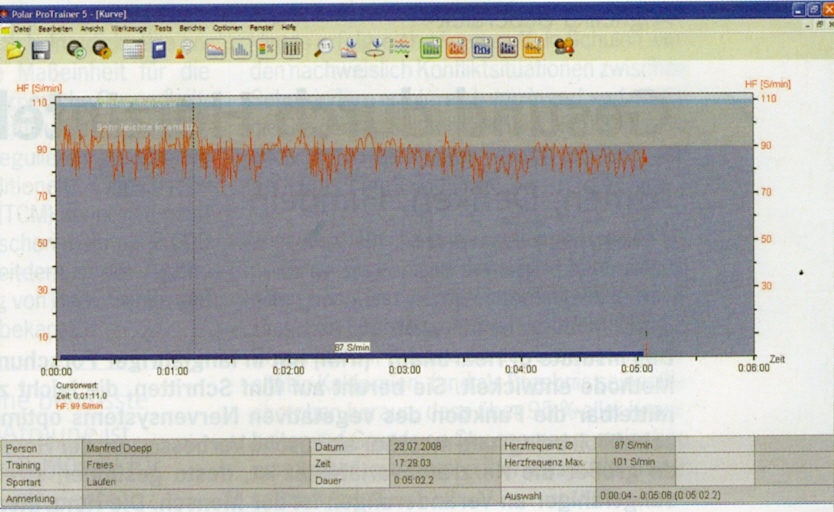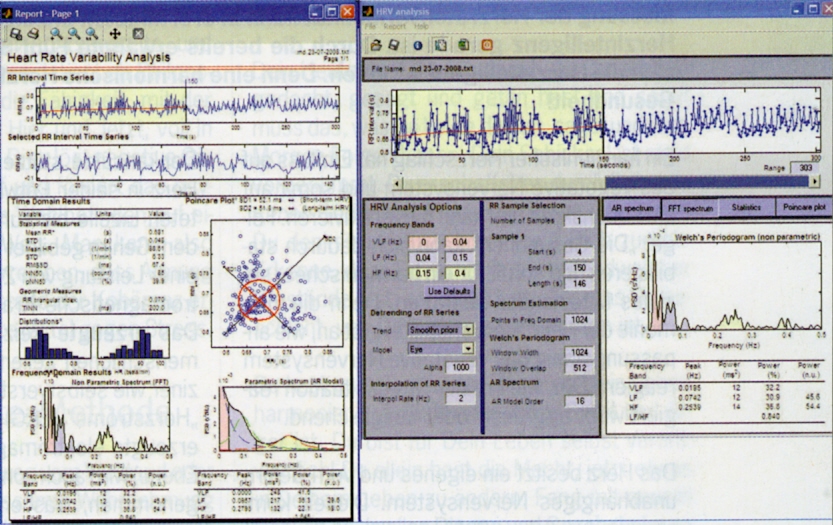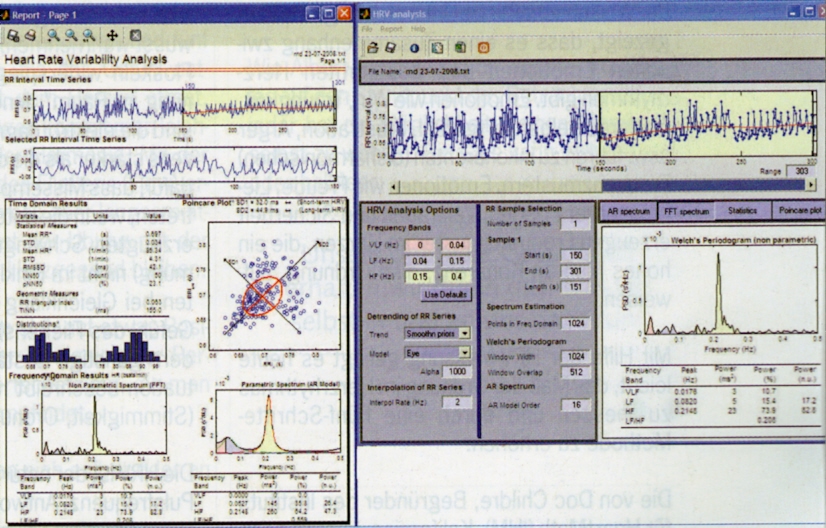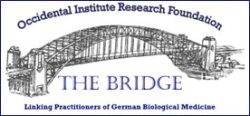The HRV as a Therapy Prognosis Method
Until recently the determination of the Heart Rate Variability (HRV) was an insignificant method in Central Europe. In a number of other countries, it indisputably belongs to conventional medicine, while in Germany even many cardiologists do not do much with it. At most it is used as an additional program for the evaluation of the 24-hour ECG. Its most widespread application is found in sports medicine, where in this respect it also appears that the Polar sports clock manufacturer offers a training clock which is HRV capable.
Complementary medicine could use this opportunity to “acquire” this method. This would be justifiably done. After all on the one hand it is completely free from worries, and on the other hand it makes possible excellent insights into the state of the vegetative nervous system (VNS) and the regulation capability of the organism. The relation between the activities of the sympathetic (Sym) and the Parasympathetic / Vagus (Vag) can be calculated with the help of spectral analysis of the RR intervals*, from which a quantitative evaluation of the stress condition results. Table 1 shows the important parameters of the HRV and its translation into understandable language.
* Riva Rocci (blood pressure measurement intervals) in ECG

The heart rate itself is relatively unimportant since it is dependent on too many factors. At first sight you can perform evaluations if you look at the generated graphics, for example the spread diagram (Poincaré Plot), the frequency distribution (histogram) and both spectra (non-parametric = fast Fourier Transformation or FFT in Welch’s Periodogram, and parametric / calmed = Autoregressive or AR-model). It is also important whether the respiration rate is dealt with or calculated out. Both have advantages and disadvantages and must occur according to a purposeful objective.
However as a layman one envisions he must be healthy if when at rest the heart beat runs on as regularly as possible. This is a mistake because the regulation of the heart rate represents a non-linear system which must react immediately to every factor of influence and thus needs an instability (chaos in order).
Health is an average variability (distribution according to the golden section), and both extremes of rigidity (excessive lognormal distribution) and of chaos (Gaussian distribution) are equally pathological.
However a rigidity is more dangerous because that is where such a heart attack danger exists, whereas a chaotic arrhythmia shortens the life expectancy less.
Now we ask ourselves the question whether here the VNS by means of the HRF allows the evaluation of the system, as well as the effect of medications, or rather to evaluate medications prognostically. For this you should have to present the medication to the body only in the form of a virtual therapy simulation, thus without taking it. We established that this is possible in an excellent manner. The localization of the medication occurs either on the bellybutton (solar plexus) or the breastbone (Thymus), whereas the hands have proved less suitable.
An example is quoted:
The test person was measured in connection to an athletic activity which went along with a certain exhaustion. The measurement ran more than five minutes: basic measurement 150 seconds in length, 150 seconds in length with a vial of Natrium muriaticum C30 globuli on the breastbone. Figure 1 shows the course of the heart rate as a curve. You recognize right away two phases of the examination: a strong variation in the first half and a calming in the second half, where the heart rate itself hardly changes because it is always about the variability with the HRV.

Figure 1: Course of the heart rate over five minutes
If you now compare Figures 2 and 3 (report pages, basic condition as well as medication test), some serious differences catch the eye. These are quantitatively shown in Table 2 with the help of the previously mentioned important parameters (non-parametric spectrum).

Figure 2: Analysis of the first half of the HRV, with basic condition.

Figure 3: Analysis of the second half of the HRV, with Nat. mur. C30 globuli (sternal)

There is an arrhythmia under the basic condition which comes close to a burnout state. The medication Nat. mur. C30 improves this state all of a sudden. Though the oversized variance is not normalized, it is however considerably calmed and is brought nearer to order. The medication is therefore effective and indicated. The fact that here this went along with a Vagus stabilization is not usual, but is possible.
We have investigated in our trials how short the test duration for the medication can be to obtain secure results. It turned out that you can exchange the test medication every 40 seconds, but if you want to make sure every 60 seconds.
Result
As a result of its non-linearity, the VNS is obviously a sensitive and responsive measurement system
Therefore the HRV enables – besides its diagnostic quality for regulations analysis – a therapy success prognosis in virtual form. Since it is considered as a scientifically recognized method, you can also pull it along as a reference for Complementary Medicine medication testing. The program applied here originates in a university and fulfills all the standards which are set today for an HRV evaluation. Besides, the method is very inexpensive.
 An Exclusive Translated Article for Members
An Exclusive Translated Article for Members
From THE BRIDGE Newsletter of OIRF
Published September 2009
From an article in CO’MED, Nr. 06 / 2009
Machine Translation by SYSTRAN, Lernout & Hauspie, LogoMedia & Promt
Translation & redaction by: Carolyn L. Winsor, OIRF
© Copyright 2009, Dr. Manfred Doepp, Prien, Germany



